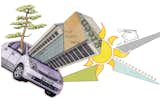
The Eco-Design Movement
This story was originally published as part of an "Architectural Movements 101" package in Dwell’s May 2007 issue.
Like an endangered species, green design has a fragile hold on life. True, all the design and architecture schools are teaching it, Walmart is marketing it, and venture capitalists are investing in it. But it had better be more than that; it had better become the movement to end all movements or we will all be facing what the self-described "former next president of the United States" has bluntly called "an inconvenient truth."
Although as a movement eco-design is still relatively fresh and unformed, some emerging trends can already be discerned. First, there is what might be called the moralistic approach: Be less bad. Get rid of your SUV and buy a Prius. The problem here is that, according to Worldchanging.org, a minimum of 50 to 60 percent of the lifetime energy consumption of a car goes into its manufacture and shipping, so this may translate into feel-a-little-too-good-a-little-too-late. At the other end of the spectrum, William McDonough and Michael Braungart are trying to design buildings that are not just "energy efficient," but net energy producers.
Eco-design’s most colorful prophet is Bruce Sterling, author of an unending stream of Viridian manifestos. Sterling’s bottom line? We must ditch the bad habits of the past, and create a new "viridian" green future.
Published
Last Updated
Get the Dwell Newsletter
Be the first to see our latest home tours, design news, and more.